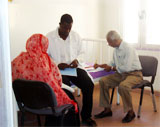 The four-day evaluation was carried out by an external team with international and national members. The activity had the objectives to: a) assess whether IMCI paediatric teaching, introduced at FMUG in 2002, improved student competencies in managing under-five children; b) make recommendations to further strengthen the teaching programme, and c) build national capacity for these evaluations. As an intermediate step, the evaluation also aimed to assess the quality of teaching resulting from the introduction of IMCI in paediatrics teaching.
The four-day evaluation was carried out by an external team with international and national members. The activity had the objectives to: a) assess whether IMCI paediatric teaching, introduced at FMUG in 2002, improved student competencies in managing under-five children; b) make recommendations to further strengthen the teaching programme, and c) build national capacity for these evaluations. As an intermediate step, the evaluation also aimed to assess the quality of teaching resulting from the introduction of IMCI in paediatrics teaching.
The methodology was based on the standard methodology described in the Guide to the Evaluation of IMCI Pre-service Education, developed by the Regional Office and expected to be published early in 2010. The overall environment at FUMG was found to be highly supportive to IMCI. Teaching of the IMCI approach had been endorsed formally at all levels and included not only in paediatric clerkship but also in ‘system courses’ over the various semesters. All teaching staff at the department had been trained in IMCI—giving a reasonable staff to student ratio of 1:14 during clinical teaching. All the materials used were consistent with the national IMCI guidelines. In such a community-oriented institution keen to introduce public health approaches, there was close collaboration between the paediatrics and community medicine departments, which had jointly defined complementary learning objectives for the respective teaching programmes, so as to be able to cover all IMCI tasks—from assessment to identification of treatment and counselling—and age groups (young infant and older children). 13% of the total paediatric teaching time was assigned to IMCI, including a lecture and 5 clinical OPD sessions. IMCI-related items had been included in the examination matrix of the department, with 8.8% of the total marks assigned to IMCI. Reference materials—e.g. IMCI chart booklet—were procured for free by the MOH and lent to students, to be returned at the end of the rotation, this representing an important constraint. Student and teaching staff attitudes toward IMCI were very positive, with students greatly appreciating the clinical sessions, as also seen in previous evaluations in other medical schools in different countries.
The student knowledge test—a test of average difficulty—and clinical skill test—including children with moderate and severe conditions —helped identify areas requiring strengthening in teaching. Students had difficulty in applying knowledge to given case scenarios, were relatively comfortable in assessing sick children but had difficulty in ‘integrating’ the different components of the IMCI algorithm. Main recommendations included adding practical teaching sessions to better prepare students for the clinical sessions with actual patients, ensuring supervised clinical practice utilizing also primary health care centres, addressing the (sustainability) issue of provision of the IMCI chart booklet and other materials to students and improving student ability to integrate the different components of the IMCI algorithm. This was the 4th evaluation of a medical school—as part of IMCI pre-service education—supported by the Regional Office after those conducted at the paediatrics departments of the universities of Alexandria and Mansoura, in Egypt, and Khartoum, in Sudan.





 IMCI pre-service education: guide to evaluation
IMCI pre-service education: guide to evaluation